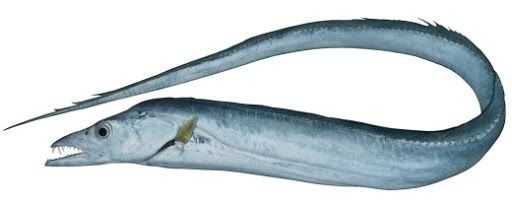Largehead Hairtail

Species Details
Trichiurus Lepturus
Trichiuridae
Perciformes
Rivers, Flats
10 - 13 lbs.
74" - 92"
Largehead Hairtail (Trichiurus lepturus) Fish Description
Also known as Beltfish, Pacific cutlassfish, Japanese cutlassfish, Cox’s Hairtail, Ribbonfish, and Atlantic cutlassfish, the Largehead Hairtail belongs to the cutlassfish family Trichiuridae.
The Largehead Hairtails have an iridescent glow. They are silvery blue in color with generally semi-transparent fins tinged with yellow. Their bodies are elongated and their tails are pointed and very thin. The eyes of Largehead Hairtails are huge and their mouths are also big with fang-like teeth. They don’t have pelvic and caudal fins; however, they have 3 dorsal spines with 130 to 135 dorsal soft rays and 100-105 anal soft rays. Their anal fin is simply small spinules that seem to slightly break through from their bodies. The Largehead Hairtails have a lateral line starting from the gill cover until just before the tip of the pectoral fins.
Diet and Size
The Largehead Hairtails are nocturnal. They feast on small fishes and krill during the night. After feeding, they return to the sea bed during the day. They also prey on shrimp and squid. Cannibalizing the young Largehead Hairtails is common among the adults.
Largehead Hairtails can grow up to 7.7 feet or 92 inches in length and weigh up to 13 pounds. On average, they measure about 1.6 feet or 19 inches to 3.3 feet or 40 inches. Those found in Australia grow as long as 5.9 feet or 71 inches. The oldest recorded age of Largehead Hairtails is 15 years old.
Interesting Facts About the Largehead Hairtail
- Each female Largehead Hairtail can produce several thousands of pelagic eggs which hatch only after 3 to 6 days.
- The Largehead Hairtail is easy to debone; it is also called ‘swordfish’.
- The meat of Largehead Hairtail is used for the Japanese dish sashimi (sliced raw meat).
- The Largehead Hairtails turn silvery grey (from being steel blue) sometime after their death.
Largehead Hairtail — Fishing Techniques
The Largehead Hairtails are considered the sixth most important commercial fish species. They are commonly captured by anglers using beach seines and bottom trawls. In 2009 alone, 1.2 million tons of this species were harvested in Taiwan and China. Large catches of Largehead Hairtails are also recorded in Pakistan, Japan, and South Korea.
Anglers can also opt for trolling, bag nets in estuaries, boat seines, and midwater longlines.
Habitat and Distribution
Largehead Hairtails are a common benthopelagic species of fish and can be found in temperate and tropical oceans throughout the globe. They like varying temperatures depending on the location. For example. In Japan, they like waters with temperatures ranging from 68 °F to 75 °F; in Korea, 57 °F is their preferred coldness. They are found in waters as deep as 1,900 feet. Largehead Hairtails love salt and brackish waters.
In the West Atlantic, they are located from Virginia to northern Argentina, including the Gulf of Mexico and the Caribbean Sea. In the east Atlantic, they span the waters from the United Kingdom to South Africa. In the East Pacific, they are abundant in southern California to Peru. They are also widespread in the Indo-Pacific region, teeming in the waters of Japan, Australia, Fiji, and the Red Sea. Strangely, they are not found in the central Pacific Ocean like Hawaii.







